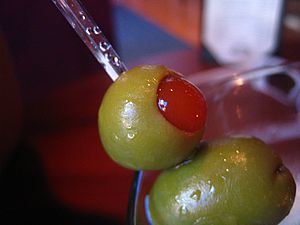Picholine facts for kids
Quick facts for kids Picholine |
|
|---|---|

The Picholine is best known as a cocktail olive.
|
|
| Olive (Olea europaea) | |
| Color of the ripe fruit | Green |
| Also called | Colliasse, Fausse Lucques, Piquette |
| Origin | France |
| Notable regions | Provence, worldwide |
| Hazards | Gloeosporium olivarum, Palpita unionalis |
| Use | Oil and table |
| Oil content | Low/medium |
| Fertility | Partially self-fertile |
| Growth form | Spreading |
| Leaf | Elliptic-lanceolate |
| Weight | 3–5 g |
| Shape | Ovoid |
| Symmetry | Slightly asymmetrical |
The Picholine is a special type of olive that comes from France. It's the most common olive grown there. Even though it started in a place called Gard in southern France, you can now find Picholine olives growing all over the world! People mostly know Picholine olives as a tasty snack, often served in cocktails. But they are also used to make olive oil. In Morocco, it's the most popular olive for making oil.
Contents
Where Do Picholine Olives Grow?
The Picholine olive first came from the Gard region in southern France. Today, you'll find it most often in Provence and other parts of France and Italy. But it's also grown far away in places like Morocco, Israel, Chile, and the United States.
Other Names for Picholine Olives
The Picholine olive has many different names, depending on where it's grown. In Gard and southern France, people might call it Coiasse, Colliasse, or Piquette. Some even call it Fausse Lucques (which means "false Lucques") or Lucques Batarde ("bastard Lucques"). In Tunisia, it's known as Judoleine. In other countries, it's often called Picholine de Languedoc. This name comes from Languedoc, the historic region where Gard is located.
What Picholine Olives Look Like
The Picholine olive tree is a medium-sized plant. It tends to spread out as it grows, and its branches form an open shape. The leaves are shaped like a long oval, similar to a spearhead. They are of medium length and width.
The olives themselves are medium-sized, weighing about 3 to 5 grams. They are shaped like an egg and are slightly uneven. The pit inside the olive is pointed at both ends. It has a smooth surface and a small tip called a mucro.
When Are Picholine Olives Harvested?
Farmers pick Picholine olives in October and November. If they are going to be eaten whole as table olives, they are picked while they are still green.
If the olives are for making oil, they are picked later. This happens after they have turned black. The exact time a farmer picks them for oil depends on what taste they want. Picking them early gives the oil a fruity flavor. Picking them later makes the oil taste sweeter.
How Picholine Olives Are Used
Picholine olives are most famous for being a cocktail olive. To prepare them this way, they are first treated with a special solution. Then, they are soaked in brine (salty water) for up to a year. This process gives them their slightly salty taste.
Picholine olives are also used to make oil. However, they don't produce a lot of oil compared to some other olives. Usually, about 20-22% of the olive's weight can be turned into oil. If the trees are watered a lot (irrigated), they might produce even less, sometimes only 15-18%. The oil from Picholine olives tastes fruity, with a little bit of bitterness.
Growing Picholine Olives
Picholine olive trees are known for producing a good and steady amount of olives each year. The tree stays a medium size. When it has fruit, it takes on a low, spread-out shape. This olive tree can grow well in many different types of soil and climates.
Pollination and Reproduction
Most experts agree that Picholine olives are only partly self-fertile. This means they need other olive trees nearby to help them produce more fruit. These other trees are called pollinators. Some olive types that help pollinate Picholine trees include the Bouteillan, Leccino, Lucques, Manzanillo, and Sigoise.
Pests and Cold Weather
Picholine trees can be affected by certain natural pests. These include tiny fungi like Gloeosporium olivarum and insects like Palpita unionalis and Liothrips oleae.
These trees are also sensitive to cold weather. An older tree can survive temperatures as low as -12°C to -14°C (10 to 14°F). But young trees need much warmer temperatures to live. This can be a challenge in the Gard and Provence regions of France, where winters can sometimes be very cold.
Creating New Olive Types
Scientists have created new types of olives by mixing the Picholine with the Manzanillo olive. This process is called hybridization. From this mixing, new olive types named Arno, Tevere, and Basento were created.
See also
 In Spanish: Picholine para niños
In Spanish: Picholine para niños

